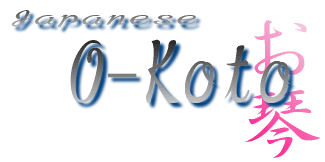One of the most famous O-koto pieces of music is "Sakura Sakura".
It's one of the keystones of Japanese culture. The main melody of this
song will be familiar to nearly all Japanese people. "Sakura"
means "Cherry Blossom" in Japanese. Try listening to it on the
Virtual O-koto below!
(hint: move the mouse below the strings so
that you don't play them twice!) The Japanese harp, or O-koto, is one of a series of Japanese classical
instruments that, along with the appropriate musical scales, give Japanese
music and culture its distinctive sound. The sound is produced by plucking
the strings using artificial "nails" which are placed over two
fingers and the thumb of the right hand.
The koto comes in several different varieties. The one featured here is the "13 string" version. Each of the 13 strings is tuned to a different note. The note produced by each string is defined by the position of the small "stands" placed under the strings. Different songs usually require different tunings, and it is not unusual for players to use several different kotos during a performance. Notes other than the 13 can be obtained by bending the strings.
VIDEO main page









